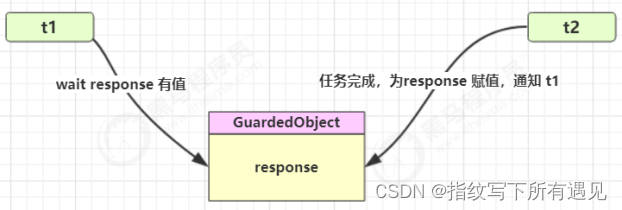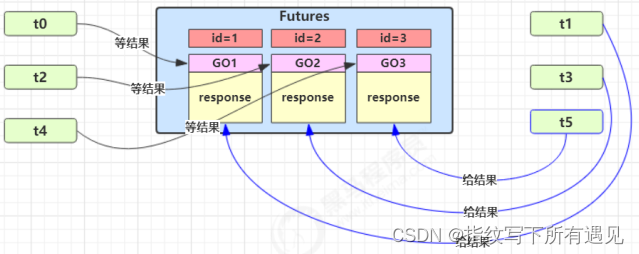同步模式之保护性暂停
.即 Guarded Suspension,用在一个线程等待另一个线程的执行结果
要点 :有一个结果需要从一个线程传递到另一个线程,让他们关联同一个 GuardedObject
如果有结果不断从一个线程到另一个线程那么可以使用消息队列(见生产者/消费者)
JDK 中,join 的实现、Future 的实现,采用的就是此模式
因为要等待另一方的结果,因此归类到同步模式

class GuardedObject{
private Object response;
//获取结果
public Object get() throws InterruptedException {
synchronized (this){
while(response==null){
this.wait();
}
return response;
}
}
public void complete(Object response){
synchronized (this){
//结果变量赋值
this.response=response;
this.notifyAll();
}
}
}
public static void main(String[] args) {
GuardedObject guardedObject = new GuardedObject();
new Thread(() -> {
try {
// 子线程执行下载
List<String> response = download();
log.debug("download complete...");
guardedObject.complete(response);
} catch (IOException e) {
e.printStackTrace();
}
}).start();
log.debug("waiting...");
// 主线程阻塞等待
Object response = guardedObject.get();
log.debug("get response: [{}] lines", ((List<String>) response).size());
}下面这个例子感觉更好一些,这里最多等5秒,超过抛出异常
public class Test15 {
public static void main(String[] args) {
GuardedObject guardedObject = new GuardedObject();
// Thread to wait for the response
Thread waitingThread = new Thread(() -> {
System.out.println("Waiting for the response...");
Object response = guardedObject.get(5000);
System.out.println("Response received: " + response);
});
// Thread to provide the response
Thread notifyingThread = new Thread(() -> {
try {
Thread.sleep(3000); // Simulate some delay
} catch (InterruptedException e) {
e.printStackTrace();
}
guardedObject.complete("Hello World!");
});
waitingThread.start();
notifyingThread.start();
}
}
class GuardedObject {
private Object response;
public synchronized Object get(long timeout) {
long startTime = System.currentTimeMillis();
while (response == null) {
long passedTime = System.currentTimeMillis() - startTime;
long remainingTime = timeout - passedTime;
if (remainingTime <= 0) {
throw new RuntimeException("Timeout waiting for response");
}
try {
wait(remainingTime);
} catch (InterruptedException e) {
throw new RuntimeException(e);
}
}
return response;
}
public synchronized void complete(Object r) {
this.response = r;
notifyAll();
}
}保护性暂停模式常用于以下场景:
- 实现生产者消费者模式中的缓冲区。
- 等待异步操作完成,如数据库查询、文件读写等。
- 控制资源访问,确保线程安全。
这种模式通过简化线程间的协作和通信,能有效解决多线程程序中的复杂同步问题。
join()的原理
是调用者轮询检查线程 alive 状态
t1.join();等价于下面的代码
synchronized (t1) {
// 调用者线程进入 t1 的 waitSet 等待, 直到 t1 运行结束
while (t1.isAlive()) {
t1.wait(0);
}
}
多任务版GuardedObject

一个送信的例子,写了我好久啊
@Slf4j(topic = "c.Test16")
public class Test16 {
public static void main(String[] args) throws InterruptedException {
for(int i=0;i<3;i++){
new People().start();
}
Thread.sleep(1000);
for(Integer id:Mailboxes.getIds()){
new Postman(id,"内容"+id).start();
}
}
}
@Slf4j(topic = "c.Test16")
class Postman extends Thread{
private int id;
private String mail;
public Postman(int id,String mail){
this.id=id;
this.mail=mail;
}
@Override
public void run(){
GuardObject_16 guardObject16=Mailboxes.getGuardObject_16(id);
guardObject16.complete(mail);
log.debug("开始送信 id:{},内容:{}",id,mail);
}
}
@Slf4j(topic = "c.Test16")
class People extends Thread{
@Override
public void run(){
GuardObject_16 guardObject16=Mailboxes.createGuardedObject();
log.debug("开始收信id:{}",guardObject16.getId());
Object mail=guardObject16.get(5000);
log.debug("收到信id:{},内容",guardObject16.getId(),mail);
}
}
class Mailboxes{
private static Map<Integer,GuardObject_16> boxes=new Hashtable<>();
private static int id=1;
private static synchronized int generateId(){
return id++;
}
public static GuardObject_16 createGuardedObject(){
GuardObject_16 go =new GuardObject_16(generateId());
boxes.put(go.getId(), go);
return go;
}
public static Set<Integer> getIds(){
return boxes.keySet();
}
public static GuardObject_16 getGuardObject_16(int id){
return boxes.remove(id);
}
}
class GuardObject_16{
private int id;
public GuardObject_16(int id){
this.id=id;
}
public int getId() {
return id;
}
private Object response;
public Object get(long timeout) {
synchronized (this) {
// 开始时间 15:00:00
long begin = System.currentTimeMillis();
// 经历的时间
long passedTime = 0;
while (response == null) {
// 这一轮循环应该等待的时间
long waitTime = timeout - passedTime;
// 经历的时间超过了最大等待时间时,退出循环
if (timeout - passedTime <= 0) {
break;
}
try {
this.wait(waitTime); // 虚假唤醒 15:00:01
} catch (InterruptedException e) {
e.printStackTrace();
}
// 求得经历时间
passedTime = System.currentTimeMillis() - begin; // 15:00:02 1s
}
return response;
}
}
// 产生结果
public void complete(Object response) {
synchronized (this) {
// 给结果成员变量赋值
this.response = response;
this.notifyAll();
}
}
}21:01:27 [Thread-2] c.Test16 - 开始收信id:3
21:01:27 [Thread-0] c.Test16 - 开始收信id:1
21:01:27 [Thread-1] c.Test16 - 开始收信id:2
21:01:28 [Thread-1] c.Test16 - 收到信id:2,内容
21:01:28 [Thread-4] c.Test16 - 开始送信 id:2,内容:内容2
21:01:28 [Thread-0] c.Test16 - 收到信id:1,内容
21:01:28 [Thread-3] c.Test16 - 开始送信 id:3,内容:内容3
21:01:28 [Thread-2] c.Test16 - 收到信id:3,内容
21:01:28 [Thread-5] c.Test16 - 开始送信 id:1,内容:内容1异步模式之生产者消费者
与前面的保护性暂停中的 GuardObject 不同,不需要产生结果和消费结果的线程一一对应
消费队列可以用来平衡生产和消费的线程资源
生产者仅负责产生结果数据,不关心数据该如何处理,而消费者专心处理结果数据
消息队列是有容量限制的,满时不会再加入数据,空时不会再消耗数据
JDK 中各种阻塞队列,采用的就是这种模式

示例代码(又搞了半天)
@Slf4j(topic = "c.Test17")
public class Test17 {
public static void main(String[] args) {
MessageQueue queue=new MessageQueue(2);
for(int i=0;i<3;i++){
int id=i;
new Thread(()->{
try {
queue.put(new Message(id,"值"+id));
} catch (InterruptedException e) {
throw new RuntimeException(e);
}
},"生产者"+i).start();
}
new Thread(()->{
while(true){
try {
Thread.sleep(1000);
} catch (InterruptedException e) {
throw new RuntimeException(e);
}
try {
Message message= queue.take();
} catch (InterruptedException e) {
throw new RuntimeException(e);
}
}
},"消费者").start();
}
}
@Slf4j(topic = "c.Test17")
//消息队列类
class MessageQueue{
//消息的队列集合
private LinkedList<Message> list=new LinkedList<>();
//队列容量
private int capcity;
public MessageQueue(int capcity) {
this.capcity = capcity;
}
//获取消息
public Message take() throws InterruptedException {
//检查队列是否为空
synchronized (list){
while(list.isEmpty()){
log.debug("队列为空,消费者线程等待");
list.wait();
}
Message message= list.removeFirst();
log.debug("已消费消息{}",message);
//唤醒一下子
list.notifyAll();
return message;
}
}
//存入消息
public void put(Message message) throws InterruptedException {
synchronized (list){
while(list.size()==capcity){
log.debug("队列满了,生产者线程等待");
list.wait();
}
//消息放入队列尾部
list.addLast(message);
log.debug("已生产消息{}",message);
list.notifyAll();
}
}
}
final class Message{
private int id;
private Object value;
public Message(int id,Object value) {
this.id = id;
this.value=value;
}
public int getId() {
return id;
}
public Object getValue() {
return value;
}
@Override
public String toString() {
return "Message{" +
"id=" + id +
", value=" + value +
'}';
}
}结果
21:41:39 [生产者0] c.Test17 - 已生产消息Message{id=0, value=值0}
21:41:39 [生产者1] c.Test17 - 已生产消息Message{id=1, value=值1}
21:41:39 [生产者2] c.Test17 - 队列满了,生产者线程等待
21:41:40 [消费者] c.Test17 - 已消费消息Message{id=0, value=值0}
21:41:40 [生产者2] c.Test17 - 已生产消息Message{id=2, value=值2}
21:41:41 [消费者] c.Test17 - 已消费消息Message{id=1, value=值1}
21:41:42 [消费者] c.Test17 - 已消费消息Message{id=2, value=值2}
21:41:43 [消费者] c.Test17 - 队列为空,消费者线程等待







 本文介绍了Java中的同步模式GuardedSuspension,如何在多线程间通过GuardedObject传递结果,以及其在生产者消费者模式、数据库查询和文件读写等场景的应用。还讨论了join方法的原理和使用场景,以及消息队列在平衡生产者和消费者之间的资源消耗。
本文介绍了Java中的同步模式GuardedSuspension,如何在多线程间通过GuardedObject传递结果,以及其在生产者消费者模式、数据库查询和文件读写等场景的应用。还讨论了join方法的原理和使用场景,以及消息队列在平衡生产者和消费者之间的资源消耗。














 1019
1019











 被折叠的 条评论
为什么被折叠?
被折叠的 条评论
为什么被折叠?








